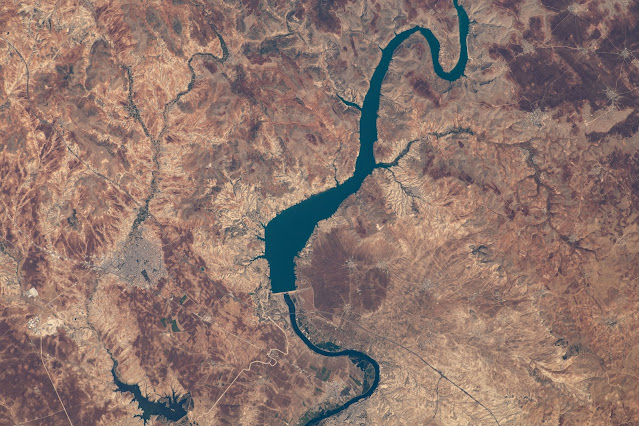ISS - Expedition 67 Mission patch.
Jul 8, 2022
Crew members aboard the International Space Station conducted scientific investigations during the week of July 4 that included testing a device to monitor spacecraft air quality, studying how microgravity affects a person’s grip and arm movements, and assessing possible adverse effects of space station noise on hearing.
Image above: NASA astronaut Kjell Lindgren snapped this photo out of the space station’s Window Observational Research Facility (WORF) of the Euphrates River below. Image Credit: NASA.
Here are details on some of the microgravity investigations currently taking place aboard the orbiting lab:
The air we breathe
Maintaining air quality in crewed spacecraft is an important part of keeping astronauts healthy and comfortable. Existing requirements cover maximum allowable concentrations of particulate matter, but currently there is no way to measure whether these requirements are met. The Airborne Particulate Monitor (APM) demonstrates an instrument for measuring and quantifying the concentration of both small and large particles in spacecraft air. Researchers plan to create a map of air quality in terms of particles, which could shed light on the sources of such particles. The data also could provide insight into the efficiency of current filtration systems and support design of better hardware for environmental monitoring of vehicles and habitats on future space missions. The ability to count particles also may be useful in future space-based research on aerosol particles or droplets. The technology has applications in environmental monitoring and air pollution studies on Earth as well. During the week, crew members conducted runs of the experiment and downlinked data to the ground.
May the (grip) force be with you
Animation above: NASA astronaut Jessica Watkins performs a session for the ESA (European Space Agency) GRIP experiment. GRIP studies how spaceflight affects a person’s ability to regulate the force of their grip and movement of upper limbs when manipulating objects. Image Credit: NASA.
An investigation from ESA (European Space Agency), GRIP studies how spaceflight affects someone’s ability to regulate the force of their grip and movement of upper limbs when manipulating objects. These abilities evolved in Earth’s gravity and must adapt to the unique conditions of microgravity. Data could help identify potential hazards for astronauts as they move between gravitational environments and contribute to the design and control of interfaces used on future exploration missions. This research also could contribute to a better understanding of how the human nervous system controls movement on the ground. Crew members conducted sessions for the study during the week.
Now hear this
Acoustic Diagnostics, an investigation from ESA, tests the hearing of crew members before, during, and after flight to assess possible adverse effects of noise and microgravity aboard the space station. Researchers compare otoacoustic emissions (OAEs), or sounds naturally generated from within the inner ear, and hearing loss from exposure to noisy environments. A noisy environment can interfere with routine hearing test results, and using OAEs as the investigation technique could avoid this problem. The advanced technology developed for this project also could improve diagnostic power and reduce the time required for OAE-based tests. Such advances may encourage more widespread use of this diagnostic tool for applications in occupational health on Earth. Crew members collected measurements during the week and downlinked results to the ground.
Other investigations involving the crew:
Animation above: Trash is deployed from the Nanoracks Bishop Airlock on Saturday, July 2. The approximately 172 pounds of waste contained packing materials, dirty crew clothing, and used office supplies. Image Credit: NASA.
- The Nanoracks Bishop Airlock is the first-ever commercially owned and operated airlock on the International Space Station. The crew worked this past week reinstalling hardware and stowing cargo inside Bishop following its trash disposal and robotic maneuvers last weekend.
https://www.nasa.gov/mission_pages/station/research/experiments/explorer/Facility.html?#id=7420
- SAMS-II, an ESA investigation, is an ongoing study of the small forces such as vibrations and accelerations on the space station caused by operation of hardware, crew activities, dockings, and maneuvering. The data help indicate whether these forces affect scientific research, crew, and equipment. Understanding the vibration environment can help researchers develop ways to minimize disturbances and even design experiments around the vibration environment.
https://www.nasa.gov/mission_pages/station/research/experiments/explorer/Facility.html?#id=963
- ESA Biofilms studies formation of bacterial biofilms and the antimicrobial properties of different surfaces in microgravity. Results could support the development of suitable antimicrobial surfaces for spaceflight and for applications on Earth such as in health care, food production, marine antifouling, and more.
https://www.nasa.gov/mission_pages/station/research/experiments/explorer/Investigation.html?#id=8177
- XROOTS uses hydroponic (liquid-based) and aeroponic (air-based) techniques to grow plants without traditional growth media, which could enable production of crops on a larger scale for future space exploration.
https://www.nasa.gov/mission_pages/station/research/experiments/explorer/Investigation.html?#id=8088
- ISS Ham Radio provides students, teachers, parents, and others the opportunity to communicate with astronauts using amateur radio units. Before a scheduled call, students learn about the station, radio waves, and other topics, and prepare a list of questions on topics they have researched.
https://www.nasa.gov/mission_pages/station/research/experiments/explorer/Investigation.html?#id=337
The space station is a robust microgravity laboratory with a multitude of specialized research facilities and tools. Over more than two decades of continuous operation, it has supported many scientific breakthroughs from investigations spanning every major scientific discipline. The orbiting lab conveys benefits to future space exploration, advances basic and applied research on Earth, and provides a platform for a growing commercial presence in low-Earth orbit.
Space to Ground: Cargo Countdown: 07/08/2022
Related links:
Expedition 67: https://www.nasa.gov/mission_pages/station/expeditions/expedition67/index.html
Airborne Particulate Monitor (APM): https://www.nasa.gov/mission_pages/station/research/experiments/explorer/Investigation.html?#id=7936
GRIP studies: https://www.nasa.gov/mission_pages/station/research/experiments/explorer/Investigation.html?#id=1188
Acoustic Diagnostics: https://www.nasa.gov/mission_pages/station/research/experiments/explorer/Investigation.html?#id=7898
ISS National Lab: https://www.issnationallab.org/
Spot the Station: https://spotthestation.nasa.gov/
Space Station Research and Technology: https://www.nasa.gov/mission_pages/station/research/overview.html
International Space Station (ISS): https://www.nasa.gov/mission_pages/station/main/index.html
Animations (mentioned), Image (mentioned), Video (NASA), Text, Credits: NASA/Ana Guzman/John Love, ISS Research Planning Integration Scientist Expedition 67.
Best regards, Orbiter.ch




